Bulletin – October 2009 Australian Corporates' Sources and Uses of Funds[1]
- Download 206KB
Introduction
Companies obtain funds from a number of sources. These include funds generated internally through profitable operations, as well as funds raised externally from banks, bond markets and equity markets. During the financial crisis, the flow and composition of listed corporates' sources of funds changed noticeably as corporates responded to evolving economic and financial market conditions. While internal funding generated from companies' operations – cash profits – was resilient, companies worked to reduce leverage and scaled back their use of external debt funding as interest margins widened. Debt also became more difficult for corporates to access, with banks tightening lending standards and bond markets effectively closed to some issuers. This followed a couple of years of very strong growth in borrowing by corporates. During the financial crisis, corporates have continued to have good access to equity markets and have significantly reduced gearing by raising equity to pay down debt. In aggregate, the stock of external funding has continued to grow, with the fall in intermediated borrowing over 2009 more than offset by strong equity raisings and some moderate bond issuance as conditions in capital markets have become more favourable.
Companies have also adjusted the use of funds in response to evolving conditions. More discretionary investment, such as merger and acquisition (M&A) activity, was scaled back substantially amid strains in financial markets and uncertainty about the economic outlook. However, investment to maintain or increase productive capacity – some of which is less discretionary in nature – was little changed during the financial crisis, and was mainly financed using funds generated internally. Many corporates have also sold assets and cut dividends, using the proceeds to repay debt.
Data
Data on listed companies' sources and uses of funds are detailed in their cashflow statements, which are disclosed semi‑annually along with balance sheets and profit and loss statements. The latest available data are for the first half of 2009.
Sources of funds comprise internal funding – that is, cash profits derived from companies' operations, after the payment of costs incurred in the usual course of running a business (such as wages) – and external funding (funds borrowed from intermediated or non-intermediated sources less repayments and new equity raisings less share buybacks; Table 1 provides more details). While cash profits tend to be correlated with accounting profits, they can differ significantly at times. This is because accounting profits are prepared on the basis of the accrual method, whereby revenues are recorded when they are earned and expenses are recorded when incurred, which may have only a weak relationship with cash inflows or outflows. For example, asset writedowns (and conversely, upward revaluations) are one such item that has recently contributed to quite large differences between cash and accounting profits. As no cashflow arises from assets being revalued, asset revaluations are not recorded in cashflow statements (only the cashflow from sales or purchases of an asset are included), whereas they do affect accounting profits.
Funds may be used to finance investment (for example, plant and equipment or M&A activity) or to make dividend and interest payments. The residual – sources of funding less uses of funding – is equal to the net change in companies' cash holdings.
| Sources of funds | |
|---|---|
| Internal funding | Cash profits: cash received from customers and non-interest bearing investments (e.g. dividends) less payments to suppliers, salaries paid to employees, and tax payments. Cash profits are not affected by depreciation. |
| External funding | |
| – Net debt | Proceeds from intermediated borrowings (for example, bank loans) and non-intermediated borrowings (for example, bonds and commercial paper) less repayments of debt. |
| – Net equity | Proceeds from new equity issuance (including initial public offerings) less buybacks. Does not include changes in the market value of existing equity. |
| Less: | |
| Uses of funds | |
| Net investment | |
| – Net physical investment | Purchases less proceeds from sales of assets that are used in the ongoing operations of a company or that maintain or increase productive capacity, such as property, plant and equipment. |
| – Net acquisitions | Purchases less proceeds from sales of other companies (in whole, or in part, including shares in listed companies), subsidiaries or large assets. Does not include asset revaluations. |
| – Other | Other investing cashflows, including net purchases of other entities' debt securities and some hedging costs. |
| Dividends paid | Dividends paid to shareholders. |
| Net interest paid | Interest paid less interest income. |
| Equals: | |
| Net change in cash | |
The analysis in this article is in terms of the flow of funding sourced or used (for example, cash profits generated, the net change in debt outstanding or investment undertaken in a half year).
The sample of companies includes all ASX-listed non-financial and real estate companies that are domiciled in Australia. In the most recent reporting period, this covers 1,205 companies.[2] For our analysis, corporates are grouped into three broad categories:
- Resource companies – companies involved in mining and energy whose output includes hydrocarbons (such as petroleum, natural gas and coal), base metals (aluminium, copper and nickel) and other minerals (iron ore and alumina). Some smaller resource companies' operations are confined solely to exploration, while the larger, more mature, companies often undertake a mixture of exploration and production. Resource companies account for just over one-half of listed corporates' market capitalisation, and around one-third of assets and debt.
- Real estate and infrastructure companies – companies (perhaps structured as trusts) that manage large and illiquid assets (for example, commercial property or toll roads). These companies have typically been highly geared, a practice that has been underpinned by relatively stable cashflows. While real estate and infrastructure companies account for only around 10 per cent of corporates' market capitalisation, their high gearing means they account for around 30 per cent of assets and 40 per cent of overall debt.
- Other corporates – these are involved in a diverse range of activities such as production, services and distribution, and includes companies in the retail, manufacturing, telecommunication, information technology and healthcare sectors. These companies account for around one-third of market capitalisation, debt and equity. We group these companies together as they tend to behave similarly in terms of sources and uses of funds.
Sources of Funds
Prior to the onset of turbulence in financial markets in mid 2007, around two-thirds of all corporates' funding was derived from internal sources – that is, cash profits from operations – with the remainder sourced externally from banks, debt markets and equity markets.[3] Resource companies relied relatively less on external funding, as their strong profit growth since 2000 provided most of the cashflows required to finance investment. Only around 10 per cent of resource companies' funding was sourced externally, compared with around 60 per cent for real estate and infrastructure companies, and 30 per cent for other corporates (Graph 1). The greater use of external debt funding by real estate and infrastructure companies reflected their tendency for debt-funded expansion prior to the crisis. As with many investors globally, real estate and infrastructure companies responded to the favourable macroeconomic and financial conditions pre-crisis by increasingly borrowing against existing assets, a practice that was supported by rising asset values. The average gearing ratio – the ratio of the book value of debt to equity – for these companies increased from around 55 per cent in 2000 to around 100 per cent by mid 2007 (see Graph 5; gearing is discussed further below).
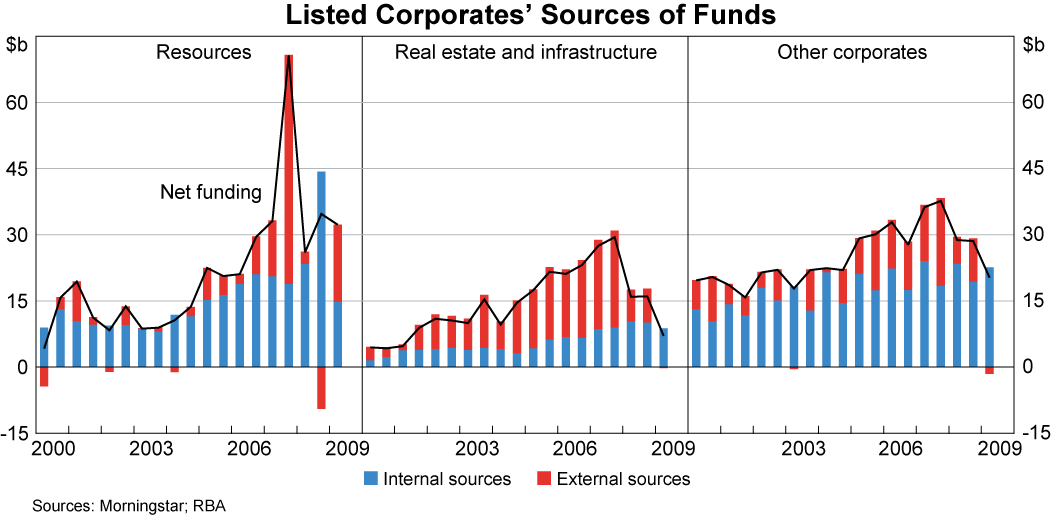
During the financial crisis, the mix of corporates' internal versus external funding has changed noticeably. Over the past two years, almost all corporates have relied more heavily on internal funding as interest margins widened, debt funding became more difficult to access and companies have worked to reduce leverage. This was possible as listed corporates' internal funding has been resilient despite the deterioration in economic and financial conditions since mid 2007.
Resource companies generated cash profits of around $40 billion for the 2007/08 financial year – similar to the year before the credit crisis – with cash profits then increasing by around 40 per cent in the most recent financial year, despite a moderate fall in the June half of 2009. This pick-up was largely due to higher average commodity prices over the period. Real estate companies' cash profits have been steady over the past couple of financial years at around $10 billion, underpinned by strong rental income owing to high rents and low office vacancy rates. While infrastructure companies' cash profits have also remained solid at around $6 billion, some companies whose cashflows have been more affected by slowing economic activity (such as those that own airports or toll roads) have seen cash profits fall a little. Many real estate and infrastructure companies have recorded large accounting losses because of asset writedowns – which do not affect cash profits – reflecting falls in commercial property prices and declines in the value of infrastructure companies' assets whose cashflows are more positively correlated with economic activity. Other corporates' internal funding has also been steady at a high level for the past couple of financial years at around $40 billion, consistent with the comparative resilience of the Australian economy.
The flow and composition of corporates' external funding has changed significantly during the financial crisis (Graph 2). The use of external funding declined sharply in 2008 as companies scaled back their use of debt as risk and uncertainty increased sharply. Many corporates postponed debt-funded investment expenditure due to higher-than-usual uncertainty about the economic outlook.[4] Debt also became more costly and less available as banks tightened the terms on which they would extend finance, though most companies were still able to roll over bank loans. Bond markets were effectively closed to many corporates.
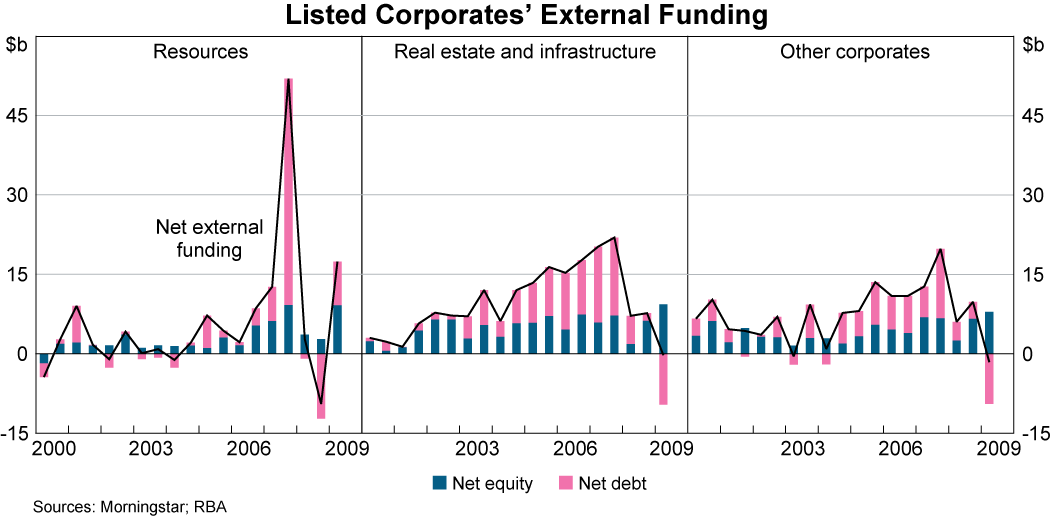
With corporates continuing to raise equity funding, but net debt funding declining sharply, the composition of corporates' external funding shifted away from debt toward equity. This occurred in two distinct phases. First, in 2008, corporates reduced their reliance on debt noticeably, with listed corporates' new borrowings declining to less than $1 billion, from around $100 billion in 2007. The slowdown in borrowing was broad-based among sectors, though during this stage only resource companies actually reduced their debt levels (by $13 billion), mostly using funds generated internally. The second phase of corporates' shift from debt to equity funding involved more active balance sheet adjustment once market conditions improved slightly, with many corporates raising equity to pay down debt.
Already-listed corporates (that is, excluding initial public offerings) have raised $64 billion of equity so far in 2009. Most of this has been used to reduce debt, mainly bank loans (Graph 3). This has contributed to the recent decline in business credit – intermediated borrowing by listed and unlisted businesses – of around 7 per cent in annualised terms over the past six months. There was a general desire by companies to decrease debt over the past year, though some corporates, particularly real estate and infrastructure companies, have been required to undertake equity raisings as a condition for the continued availability of loan finance. Corporates also reduced debt during the recession of the early 1990s, though on that occasion the bulk of funds used to repay debt was sourced from internal funding (Graph 4).
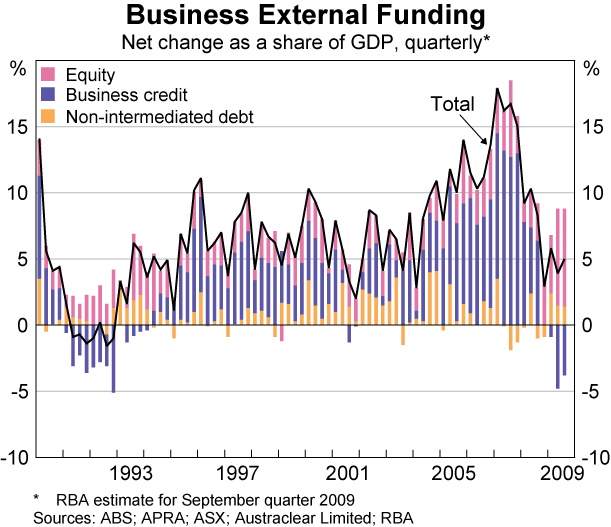
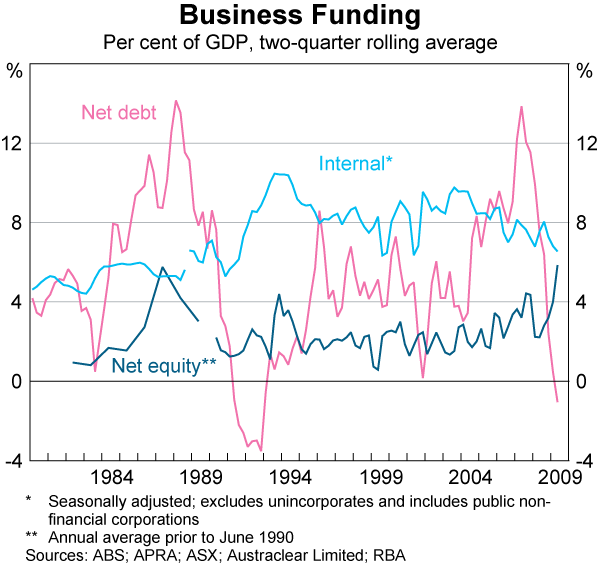
Over the past two years, there has also been a change in the composition of debt funding. While intermediated borrowing has declined, this has been partly offset by corporates tapping the bond market as wholesale market conditions improved in 2009. Initially, as the bond market started to reopen, issuance was limited to larger corporates with an established presence in capital markets, though more recently the range of borrowers has broadened with some medium-sized corporates also issuing bonds.
The bulk of equity has been raised through placements and rights issues to institutional investors (mostly fund managers), often followed by smaller issues to retail investors. Investor demand has been solid, with many issues oversubscribed, partly because investors could usually purchase the new shares at a modest (and in a few cases, large) discount to prevailing market prices. Equity raisings have historically been offered at a discount to market prices, with the discount typically higher if the raising is large relative to the company's existing market capitalisation. These trends were also evident for equity raisings undertaken this year, though the average discount was a little larger than has been the case historically, at around 20 per cent.
These equity raisings were the primary reason for a fall in listed corporates' debt levels of around 15 per cent over 2009 so far, to around $365 billion. Consistent with this, corporates' gearing ratio is estimated to have declined by around 20 percentage points to around the historical average of 65 per cent (Graph 5).[5] By sector, resource companies' raised around $30 billion of equity funding. Proceeds were used for a combination of investment and debt reduction, though some resource companies continued to borrow in 2009, mainly by issuing bonds offshore. The reduction in leverage has also been pronounced among non-resource companies. Real estate and infrastructure companies raised $18 billion of equity over the year to date, almost all of which was used to pay down their level of debt. While these companies' debt outstanding fell by 15 per cent to around $150 billion, their leverage was also affected by asset writedowns. Although their gearing ratio declined from around 130 per cent to 115 per cent currently, it is up from around 90 per cent at the beginning of the crisis owing to asset writedowns. Some of these companies are still in the process of restructuring their balance sheets, including by negotiating the sale of assets to reduce gearing. Other corporates raised nearly $15 billion of equity, with debt levels declining by a little more as some internal funding was also used to pay down debt.
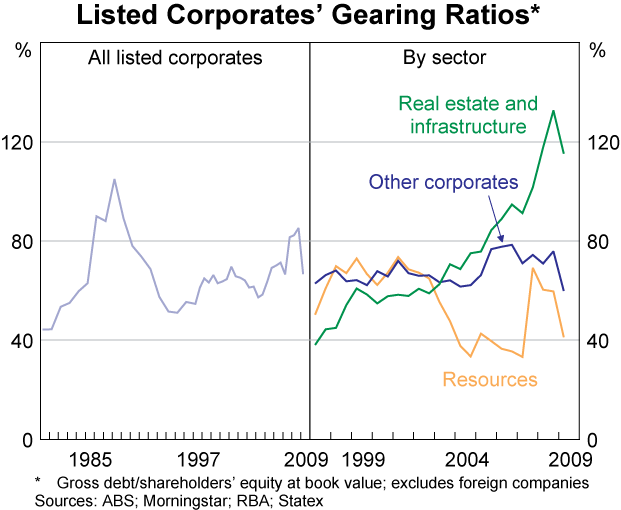
Equity raisings have tended to be undertaken by the most highly geared companies, a trend consistent across most sectors.[6] Very highly geared companies – those with a gearing ratio of 100 per cent or greater – raised about half of the $64 billion of equity issued. Even these very highly geared companies have had good access to equity funding, though some needed to offer large discounts to the prevailing market price.
Uses of Funds
After paying costs associated with running their operations – which are included in cash profits – corporates use funds to pay interest on debt, make dividend payments to shareholders and fund investment. Investment expenditure has typically accounted for roughly two-thirds of corporates' uses of funds, with dividend payments accounting for the bulk of the remainder (Graph 6). This is broadly consistent across sectors. In aggregate, net interest paid is a relatively small component of aggregate expenditure, but the effects of reducing leverage and the fall in borrowing costs over the past year are evident, with net interest paid declining by 20 per cent in the June half 2009, to $8 billion. For some companies – particularly highly geared ones such as real estate and infrastructure companies – interest costs can account for a large share of expenditure.
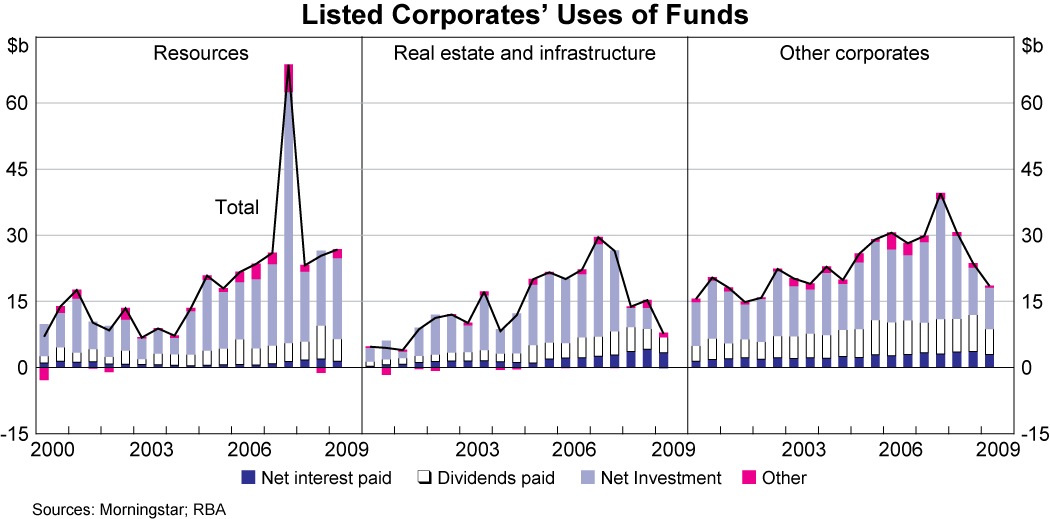
Investment reported by companies in their cashflow statements can be broadly split into three categories:
- Net physical investment in assets that maintain or increase productive capacity or are used in the ongoing operations of a company, such as machinery and equipment or building a mine. Expenditure for the maintenance of these assets can be thought of as being less discretionary in nature.
- Net acquisitions such as the purchase of other companies (in whole – for example, Wesfarmers' purchase of Coles – or in part, including shares in a listed company), sales of subsidiaries or purchase or sales of other large assets (for example, AGL's partial sale of its Papua New Guinean oil and gas interests, and corporates' purchases and sales of toll roads or commercial property). These acquisitions can be thought of as usually being more discretionary in nature.
- Other, which includes net purchases of other entities' debt securities and some hedging costs. This is usually only a small part of investment.
Physical investment in assets continued at a similar rate during the financial crisis (Graph 7). This type of investment tends to be financed using funds generated internally. However, more discretionary investment such as M&A activity, which tends to be financed externally, was scaled back amid strains in financial markets and uncertainty about the economic outlook. In fact, some corporates sold assets (often to unlisted companies or foreign companies outside our sample), resulting in negative net acquisitions for corporates as a whole, and others sought to conserve cash by postponing investment expenditure.
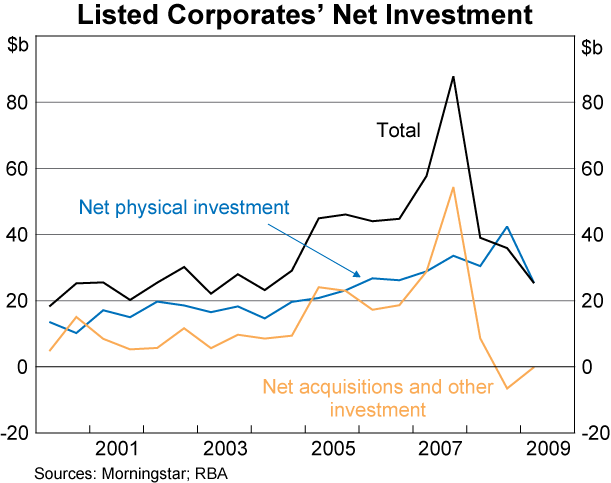
This slowing of net investment has been particularly evident for non-resource companies (discussed further below), while resource companies' investment has remained above the average of the previous five years (the spike in the second half of 2007 reflects Rio Tinto's purchase of Alcan in July 2007; Graph 8). The bulk of resource companies’ investment expenditure continues to be directed toward physical assets that maintain or increase productive capacity, such as building mines and purchases of other mining-related infrastructure. The ongoing investment in these assets – many of which have quite long life spans and lead times – is consistent with an expectation that long-term demand for commodities from emerging market countries, particularly China, will remain strong despite some near-term declines of sales volumes and associated falls in commodity prices. The trend toward acquisition activity in the lead-up to the financial crisis (including Rio Tinto's purchase of Alcan) was reversed in 2008, with a couple of large resource companies selling assets for capital management, including paying down debt.
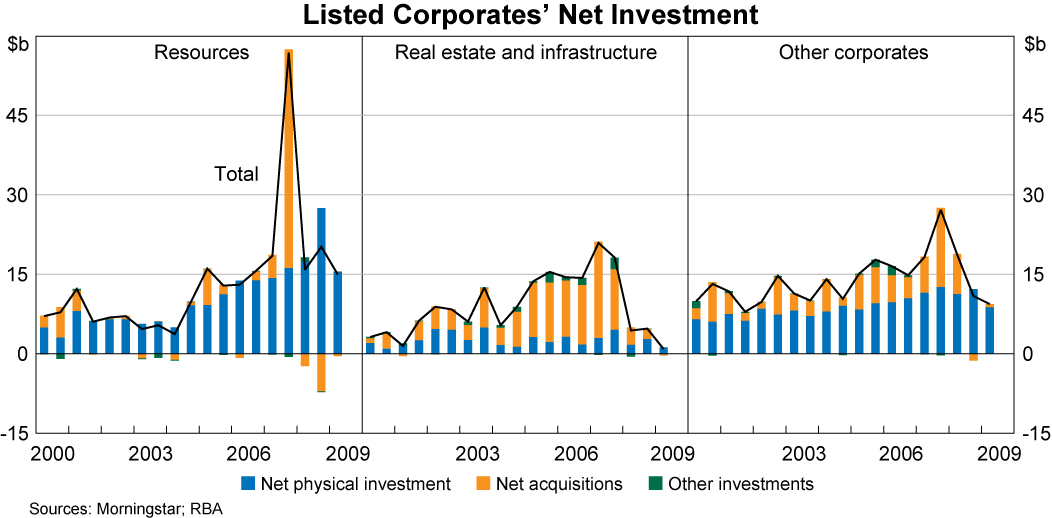
The scaling back of investment expenditure over the past couple of years is particularly noticeable among non-resource corporates. For real estate and infrastructure companies, the bulk of investment expenditure has traditionally been for acquisitions of new assets, which may be characterised as discretionary investment. Real estate companies mainly acquired commercial property, while infrastructure companies expanded rapidly by purchasing a diverse range of assets, including toll roads, airports, seaports and power stations, many of which were domiciled overseas. Both real estate and infrastructure companies funded a relatively large amount of these acquisitions with debt, and consequently scaled back these transactions significantly amid the strains in financial markets. Net acquisitions by these companies peaked at $30 billion in the year before the financial crisis, falling to $1½ billion in the 2008/09 financial year. Some companies sold assets to pay down debt and reduce gearing as lenders became more stringent about the terms on which they would roll over loans. This contributed to a small net divestment of assets in the most recent half year. Some real estate and infrastructure companies made losses on the sales of assets as they were sold at prices below their recorded book values. These losses, like asset writedowns, affect accounting profits but not companies' cashflows (though the amount for which the asset is sold is reported in the cashflow statement and reflected in Graph 8). Corporates in the ASX 200 have reported $43 billion of net accounting losses from asset sales and writedowns during the financial crisis, equivalent to around 5½ per cent of assets (Graph 9). These were concentrated among real estate companies ($29 billion), amounting to around 15 per cent of their assets.
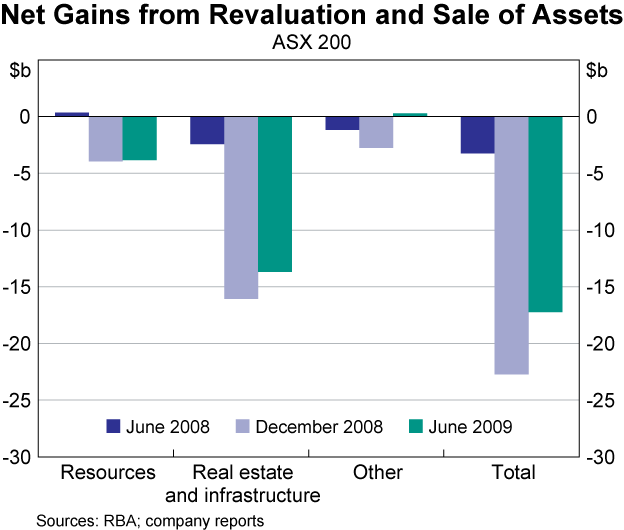
In contrast to acquisitions, real estate and infrastructure companies' investment in physical assets – which accounted for a relatively small proportion of these companies' overall investment expenditure – is little changed over the crisis period, notwithstanding a fall in the most recent half year. The relative resilience of this type of investment is likely because some of it is required for the upkeep and replacement of existing assets and hence is less discretionary in nature.
Other listed corporates have also scaled back their discretionary investment expenditure over the past couple of years. Most of the growth in other corporates' investment expenditure prior to 2008 reflected acquisition activity, including acquisitions of shares in other listed and unlisted companies for strategic purposes. More recently as investors have become more optimistic about the outlook and conditions in financial markets have improved, market reports have suggested that a pick-up in M&A activity may be imminent, though only a few large transactions have been announced to date. Other corporates' investment in physical assets has remained reasonably solid at around $10 billion per half year. In the most recent half year, however, there was a small fall in physical investment, mostly driven by retailers, likely reflecting the uncertain environment.
Another way that listed corporates have sought to conserve cash and repair their balance sheets is by cutting dividend payments to shareholders or, in some cases, paying no dividend. During 2009 to date, nearly 60 per cent of ASX 200 corporates have announced cuts in dividends, often for the purpose of conserving cash to pay down debt (Graph 10). This has been particularly true for more highly geared corporates such as real estate and infrastructure companies, for which aggregate distributions paid to shareholders declined by around 20 per cent in the 2008/09 financial year, to $7 billion, with around 85 per cent of these companies cutting dividends.
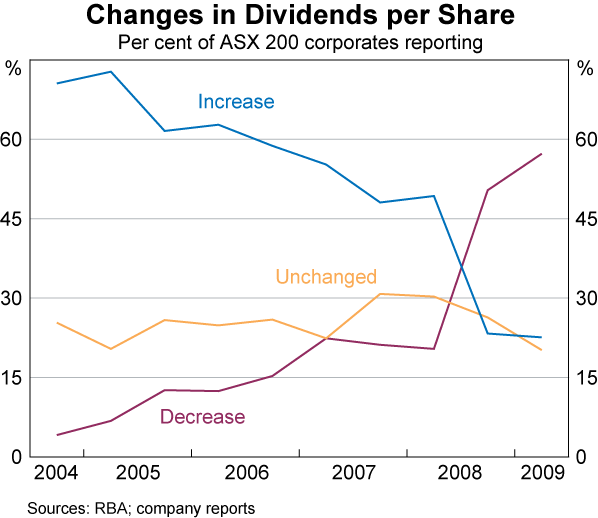
While real estate companies were traditionally considered to be a defensive investment that paid stable dividends, many have needed to change their dividend policy recently. In the past, some real estate companies borrowed against rising commercial property values partially to fund the payment of dividends in excess of cash profits. This underpinned their high payout ratio – around 90 per cent of profits compared with a little over 50 per cent for other listed corporates. Reduced borrowing capacity and profitability have led to these companies scaling back their dividend payout ratios, or in some cases paying no dividend as they move to a more conservative capital structure. Some real estate companies have also sought to retain cash by introducing dividend reinvestment plans.
Other corporates reduced dividend payments by around 15 per cent. While resource companies increased dividends over the 2008/09 financial year, this was driven by a pick-up in distributions in the December 2008 half, underpinned by quite large cash balances and good profitability. Around 40 per cent of resource companies scaled back dividends in the June half 2009, with aggregate dividends declining by around 15 per cent compared with the previous corresponding half year, the first decline since 2000. The dividend payout ratio increased as companies sought to minimise dividend reductions despite lower cash profits.
Change in Cash Holdings
Sources of funds less uses of funds is equal to the net change in corporates' cash holdings. Reflecting the increased uncertainty throughout the crisis period and the environment of tighter lending standards and greater difficulty rolling over debt, corporates sought to conserve cash for precautionary purposes. Many companies used these cash holdings to undertake balance sheet adjustment. Resource companies in particular increased their cash buffer – with cash balances increasing to 10 per cent of assets at end June 2009 – though this largely reflected their ongoing robust cash profits (Graph 11). Both real estate and infrastructure companies and other corporates increased their cash balances throughout the crisis period, with cash holdings as a share of assets reaching a relatively elevated level compared with history.
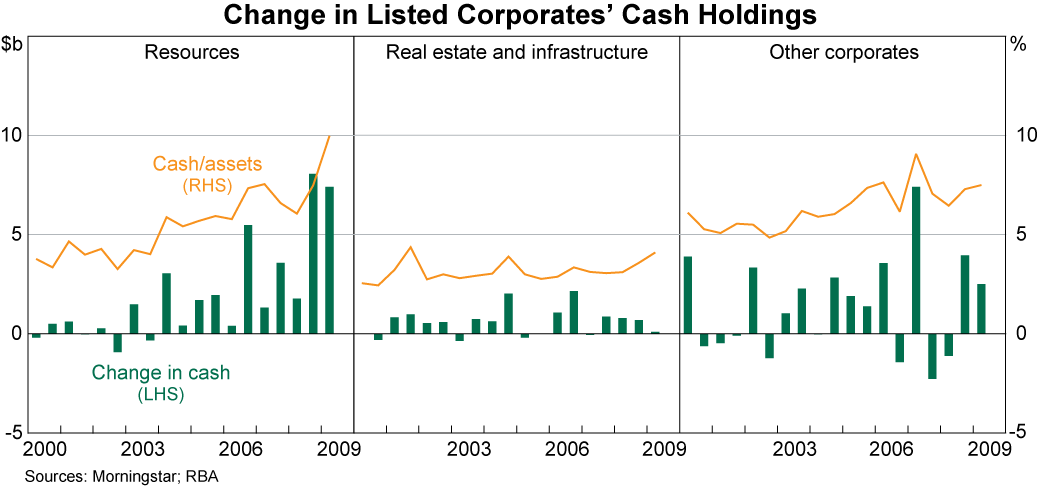
Conclusion
After a period of heavy debt raisings, most of which was used to fund acquisition activity, companies have responded to the evolving economic and financial conditions by reducing their use of external funding, and changing its composition from debt to equity. Corporates' internal funding has remained resilient. Many companies are moving to a more conservative capital structure by raising equity to repay debt, particularly bank debt. In general, the corporate sector is in good financial shape, with many companies having reduced leverage.
Amid the increased uncertainty about the economic outlook and a tightening in the availability of finance, corporates have postponed more discretionary activity such as acquisitions. Expenditure such as physical investment required for the upkeep and replacement of existing assets has remained reasonably solid. Companies have also adjusted the composition of their balance sheets by cutting dividends and selling assets.
Footnotes
This article was prepared by Susan Black, Joshua Kirkwood and Shah Shah Idil of Domestic Markets Department. [1]
The sample of companies changes through time as companies are listed and delisted. Using a matched sample of companies, rather than an evolving sample, does not materially alter the results presented in this article. [2]
The dominance of internal funding in corporates' overall funding is an oft-reported stylised fact. For example, Myers reports that for US corporates ‘external financing in most years covers less than 20 percent of real investment' (p 82). See Myers SC (2001), ‘Capital Structure’, Journal of Economic Perspectives, 15(2), pp 81–102. [3]
The sharp increase in resources companies' use of external funding in the second half of 2007 reflected Rio Tinto's debt-funded purchase of Alcan, which was announced in July 2007 – before the increase in uncertainty in equity markets. As discussed below, Rio Tinto undertook a large equity raising two years later, with these funds used to repay debt associated with the takeover of Alcan. [4]
This takes into account equity raisings since end June 2009, such as Rio Tinto's $19 billion equity raising in July, which are not included in the latest data in Graphs 1 and 2 as they are up to the June half 2009. [5]
See ‘Box C: Equity Raisings and Company Gearing', RBA Financial Stability Review, September 2009, pp 59–61. [6]